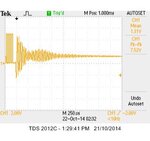Huixin Zhang
Newbie level 2
Hi,
I am trying to use one ultrasonic transducer for RX and TX. The transmitted signal was 25 KHz square wave from Arduino Uno, and the switch is controlled by Arduino. The result is shown as the following picture.

The four cycles of square wave is the transmitted signal and after that it is the received signal. My question is: why the amplitude of the received signal is greater than the transmitted signal? Thank you very much.
I am trying to use one ultrasonic transducer for RX and TX. The transmitted signal was 25 KHz square wave from Arduino Uno, and the switch is controlled by Arduino. The result is shown as the following picture.

The four cycles of square wave is the transmitted signal and after that it is the received signal. My question is: why the amplitude of the received signal is greater than the transmitted signal? Thank you very much.